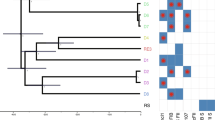Abstract
Plasmids have an important role in the pathogenicity of certain bacterial species, and Escherichia coli provides the most complete example of the relationship involved. Enterotoxigenic strains of E. coli, in addition to producing heat-stable and/or heat-labile enterotoxins, may also produce a haemolysin and fimbriate cell surface antigens which facilitate the adherence of the bacterial cell to the mucosa of the small bowel. Numerous studies have shown that these properties are plasmid-mediated1–5 and that the plasmids act in concert to confer on the host bacterium the ability to produce enteric disease in man and in animals. Moreover, studies with invasive strains of E. coli have shown that the Col V plasmid, which codes for the synthesis of colicin V, significantly enhances the pathogenicity of its host bacterium6,7. Although the relationship between Col V plasmids and virulence is unclear, reports indicate that Col V-containing strains of E. coli are better able to survive in the alimentary tract and that colicine V itself inhibits macrophage function7,8. It is probable that bacterial virulence is a complex phenomenon involving both chromosomal and plasmid genes. We describe here a virulence plasmid which mediates tissue invasiveness in human pathogenic strains of Yersinia enterocolitica.
This is a preview of subscription content, access via your institution
Access options
Subscribe to this journal
Receive 51 print issues and online access
$199.00 per year
only $3.90 per issue
Buy this article
- Purchase on Springer Link
- Instant access to full article PDF
Prices may be subject to local taxes which are calculated during checkout
Similar content being viewed by others
References
Gyles, C., So, M. & Falkow, S. J. infect. Dis. 130, 40–49 (1974).
Smith, H. W. & Linggod, M. A. J. med. Microbiol. 4, 467–485 (1971).
Sack, R. B. A. Rev. Microbiol. 29, 333–353 (1975).
Evans, D. G., Silver, R. P., Evans, D. J., Chase, D. G. & Gorbach, S. L. Infect. Immun. 12, 656–667.
Moon, H. W. Adv. vet. Sci. comp. Med. 18, 179–211 (1974).
Smith, H. W. J. gen. Microbiol. 83, 95–111 (1974).
Smith, H. W. & Huggins, M. B. J. gen. Microbiol. 92, 335–350 (1976).
Ozanne, G., Mathieu, L. G. & Baril, J. P. Rev. Can. Biol. 36, 307–316 (1977).
Bottone, E. J. CRC crit. Rev. Microbiol. 5, 211–241 (1977).
Brenner, D. J., Steigerwalt, A. G., Falcao, D. P., Weaver, R. E. & Fanning, G. R. Int. J. syst. Bact. 26, 180–194 (1976).
Feeley, J. C., Wells, J. G., Tsai, T. F. & Puhr, N. D. Contr. Microbiol. Immun. (in the press).
Une, T. Microbiol. Immun. 21, 365–377 (1977).
Maki, M., Gronroos, P. & Vesikari, T. J. infect. Dis. 138, 677–680 (1978).
Lee, W. H., McGrath, P. P., Carter, P. H. & Eide, E. L. Can. J. Microbiol. 23, 1714–1722 (1977).
Black, R. E. et al. New Engl. J. Med. 298, 76–79 (1978).
Sack, D. A. & Sack, R. B. Infect. Immun. 11, 334–336 (1975).
Dean, A. G., Ching, Y. C., Williams, R. G. & Harden, L. B. J. infect. Dis. 125, 407–411 (1972).
Serény, B. Acta microbiol. acad. sci. hung. 2, 293–296 (1955).
Pai, C. H. & Mors, V. Infect. Immun. 19, 908–911 (1978).
Pai, C. H., Mors, V. & Toma, S. Infect. Immun. 22, 334–339 (1978).
Falkow, S. Infectious Multiple Drug Resistance (Pion, 1975).
Kimura, S., Ikeda, T., Eda, T., Mitsui, Y. & Nakata, K. J. gen. Microbiol. 97, 141–144 (1976).
Cornelis, G., Bennett, P. M. & Grinstead, J. J. Bact. 127, 1058–1062 (1976).
Meyers, J. A., Sanchez, D., Elwell, L. R. & Falkow, S. J. Bact. 127, 1529–1537 (1976).
Author information
Authors and Affiliations
Rights and permissions
About this article
Cite this article
Zink, D., Feeley, J., Wells, J. et al. Plasmid-mediated tissue invasiveness in Yersinia enterocolitica. Nature 283, 224–226 (1980). https://doi.org/10.1038/283224a0
Received:
Accepted:
Issue Date:
DOI: https://doi.org/10.1038/283224a0
This article is cited by
-
Susceptibility of four inbred mouse strains to a low-pathogenic isolate of Yersinia enterocolitica
Mammalian Genome (2008)
-
Monitoring of plasmid dissociation and pathogenic potential amongYersinia enterocolotica andYersinia pseudotuberculosis during storage of refrigerated pork meat
Annals of Microbiology (2008)
-
Biological peculiarities of someYersinia species: strain-dependent virulence and strain-dependent stress proteins
Annals of Microbiology (2007)
-
Detection of chromosomal- and plasmid-encoded virulence-associated epidemiological markers in Yersinia enterocolitica strains isolated from clinical cases
Molecular Diagnosis (2004)
-
Occurrence of plasmid DNA in the sepiolid squid symbiontVibrio fischeri
Current Microbiology (1994)
Comments
By submitting a comment you agree to abide by our Terms and Community Guidelines. If you find something abusive or that does not comply with our terms or guidelines please flag it as inappropriate.



